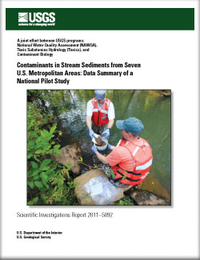This report presents data collected as a part of a synoptic survey of stream sediment contaminants, associated watershed characteristics and invertebrate responses in laboratory sediment toxicity tests from 98 streams (sites) in seven metropolitan study areas across the continental United States. The report presents methods, data, and sediment-quality guidelines, including the derivation of a new sediment pyrethroid probable effects concentration, for the purposes of relating measured contaminants to land use and toxicity evaluation. The study evaluated sites that ranged in their degree of relative urbanization within the study areas of Atlanta, Boston, Dallas-Fort Worth, Denver, Milwaukee-Green Bay, Salt Lake City, and Seattle-Tacoma. In all, 108 chemical analytes quantified in the study are presented, by class and number of individual compounds, as follows: polyaromatic hydrocarbons (PAHs) (28), organochlorine pesticides (OCs) (18), polychlorinated biphenyls (Aroclors) (3), pyrethroid insecticides (14), fipronil compounds (4), priority trace and other major elements (41). The potential of these sediments to cause toxicity to sediment-dwelling invertebrates was evaluated using two standard sediment toxicity tests: a 28-day growth and survival toxicity test with the amphipod Hyalella azteca, and a 10-day growth and survival toxicity test with the midge Chironomus dilutus. Further, approximately 95 relevant watershed and reach-level characteristics were generated and are presented to aid in interpretation and explanation of contaminant and toxicity patterns. Interpretation of the findings of this study, including the relationships with urbanization and other factors, the relationship between sediment toxicity and sediment chemistry in the seven study areas, and the sources and occurrence of pyrethroid insecticides, are discussed in detail in a forthcoming series of journal articles.


